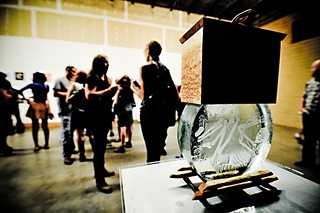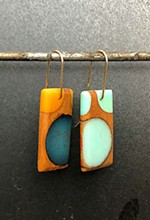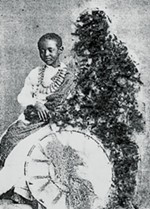Dawn in the EAST
Big Medium's Shea Little recalls the East Austin Studio Tour's beginning
By Caitlin Greenwood, Fri., Nov. 16, 2012
Shea Little gazes over Big Medium's parking lot, which has been converted haphazardly into a courtyard. Artists casually walk in and out of the converted warehouse nestled off Bolm Road, chatting amongst themselves about their expectations for the weekends ahead. Excavated car seats and overgrown plants jut out between sculptures and unfinished projects. The space is unassuming for a venue that will host thousands of guests during the next two weekends, but Little seems unfazed by the looming event as he contentedly surveys the site that has served as his home, his studio, and an epicenter for Austin's artistic growth over the past 10 years. As we begin our conversation about the East Austin Studio Tour, Little discusses the unrelenting preparation for the 2012 event, touting almost 500 participating artists and boasting an extensive 193 tour stops. Since its inception in 2003, EAST has exploded into a whirlwind of visual art and design with an estimated 15,000 attendees roaming through an endless stream of galleries, studios, pop-up shops, and DIY venues across Austin's Eastside. (The 2012 tour, which began last weekend, continues through Nov. 18.) For audiences, it is an opportunity to meet with local creatives and discuss their work in a uniquely relaxed setting. For artists, it is the largest single event in Austin to sell work, build a following, and actively engage with the public. As for Little, it was a personal attempt at directing more attention toward his art that has both mobilized a community and ultimately changed the landscape of Austin east of I-35.
After a stint out of state for college, Little returned to Austin in the early 2000s and found himself living and working out of his studio alongside fellow artists Joseph Phillips and Jana Swec. The artists sensed an increasing need to showcase their work to a wider audience while refining their own presentation. Little hoped to highlight the creative process as it truly was. "It was one of our initial things we latched on to. We were providing artists a chance to show work outside of the gallery system," explains Little. "The gallery setting is so much about this persona and this display of you and your work. The studio is this really intimate environment where you are making your work. ... It's this behind-the-scenes peek, and I wanted to show that to the audience." This approach softened the often elitist art world and opened up the tour for families, gallery frequenters, and art enthusiasts alike. It has been integral to the success of EAST and the most enjoyable characteristic of the event.
EAST's early growth was sporadic. Little, Swec, and Phillips had founded Big Medium as a sole proprietorship but quickly saw the need to reinvent the business model in order to attain financial backing for EAST. Little states, "We did the first tour just with participants pitching in money. The second tour we started selling ads in our brochure. Around the third tour, we found out about the Cultural Arts Division." Over the next year, Little, Swec, and Phillips worked toward formally establishing Big Medium as a nonprofit, and in 2007, they were offered event funding through the city of Austin's cultural contracts program. Little explains, "From 2003 until about 2008, we ran the tour and everything we did basically for free. If you added up everything we did and everything we got, it would be about a $1 an hour pay [laughs], but we were doing these things because we were passionate about it and we wanted to see it happen."
The initial tours were successful in developing larger arts awareness and enticing groups to visit what some considered troubled neighborhoods. Little pauses as he considers the evolution of the Eastside, an area struggling against cultural change. It is the one question that is difficult to answer for many of Austin's young artists who have profited off a neighborhood that is not wholly their own. Back in 2003, Little had consulted artists working out of East Austin studios prior to launching the tour, and their feedback confirmed his suspicions that people wouldn't attend exhibitions or events on the Eastside because they were wary of the area. "The stigma was still very strong. East of I-35 were the neighborhoods with high crime. 'If you go over there, you'll get shot.' That was definitely still out there. That was the general psyche of Austin." Little hoped that cultivating creative communities and inviting outside audiences would change the neighborhood's reputation, though his attempts led some to accuse him of inviting gentrification to East Austin. When asked about how to bridge the gap between the art community and Eastside residents, Little imagines more opportunities for artists to connect with their neighbors and local schools. By turning to education and local involvement, EAST can exist as a part of the community instead of alongside it, a vital step in investing into the area that has fostered its success. He explains, "We've been thinking about the impact we've had on East Austin a lot, and I think we could play a bigger role. We need to play a bigger role."
With Formula One falling on EAST's closing weekend, the race offers a stark reminder of the city's light-speed 21st century growth competing against the inherently small grassroots Austin movement. Little remains optimistic that the artistic scene will remain intact in spite of such rampant change. "We're embracing the fact that we're not the traditional model of an arts community. We don't have three to 10 major museums here. We don't have 20 commercial galleries that are selling art to a huge collector base. We have a ton of artists here, and they make a lot of work, and they show that work through whatever means possible." Regardless of what awaits Austin's art scene, the work of Big Medium and EAST has been decisive in organizing the city's creative forces. It is to Little, Swec, and Phillips' great credit that undiscovered artists are able to contribute to an established community and launch arts enterprises all their own. We look forward to participating in EAST's continued success and to begin nurturing the achievement that has yet to come.
The East Austin Studio Tour continues with open studios and "happenings" Saturday and Sunday, Nov. 17-18. For more information, call 939-6665 or visit www.eastaustinstudiotour.com.











